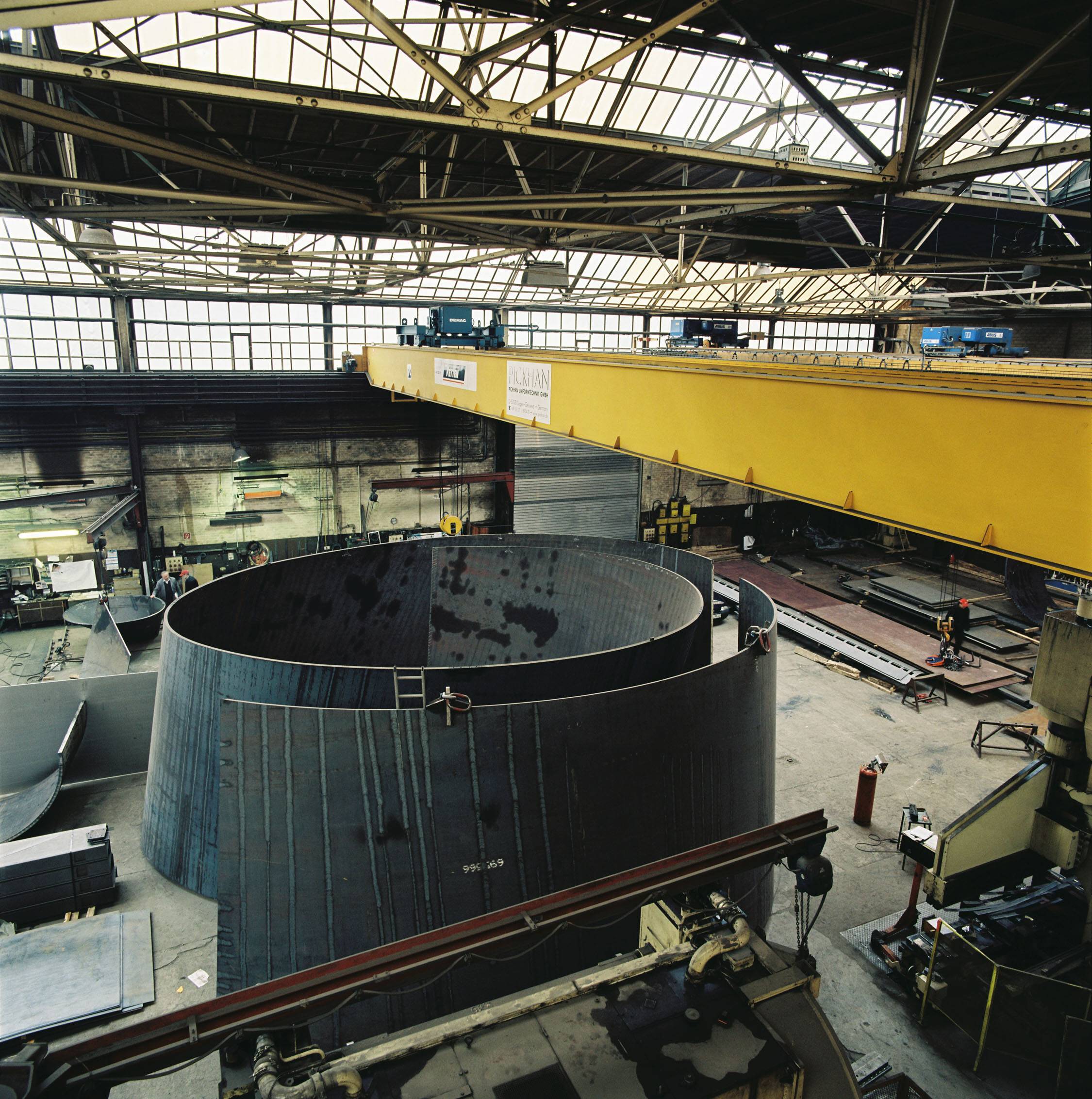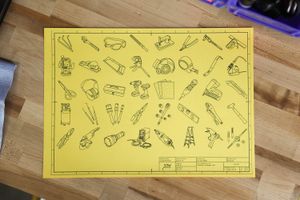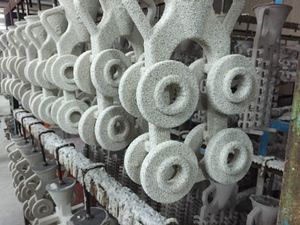One of the things I’m proudest of as a parent is the fact that my kids seem genuinely excited to spend time at my workshop. This is, no doubt, partly a result of my having purchased bulk quantities of lollipops to keep there around the time my oldest kid learned to walk. But after almost five years of semi-regular visits, I think we have transcended the pure bribery phase, and engendered a sense of mechanical curiosity and comfort in both my 4- and 6-year-old children.
For me, the hardest part about our weekend workshop visits has been their relative lack of structure. I tend to be fairly disciplined with my solo workshop time, and early on it became evident that my desire to execute a plan conflicted with my kids’ naivete and lack of manual dexterity – not to mention their inability to think more than ninety seconds into the future. And so it was with great anticipation and excitement that I planned an actual workshop activity for my kids: A scavenger hunt kit, which after extensive user testing I’m pleased to offer as SOW’s first official merch.
I enjoyed every part of the project – from writing the descriptions for each tool, to helping develop the kit’s visual style, to having the paper cut to size and printed at a Riso shop in Bushwick. I relished the opportunity to describe Dremels to my 6-year-old (“incredibly versatile, though many of the things they are used for are better suited for more specialized tools”). I delighted in the pedantry of using ISO drawing conventions for what is essentially a child’s toy (standardization is, like Wu Tang, for the children). And even if this niche piece of newsletter merch goes absolutely nowhere, it was incredibly rewarding to hear my 4-year-old call out “hammer!” like her little life depended on it.
-Spencer Wright
The most clicked link from last week's issue (~14% of opens) was Paul Hallow's infrastructure illustrations. In the Members' Slack, the #community-parents channel is a place to find kid-friendly tools, post about their favorite toys, and share all that hard work that goes into shepherding small humans into and through the world.
PLANNING & STRATEGY.
The thing that I find most shocking about J. Robert Oppenheimer’s career was how rapidly it played out. Consider these events:
- 1942-10: Oppenheimer is appointed to head “Project Y,” the Manhattan Project’s central weapons lab. He is thirty-eight years old.
- 1942-11: Los Alamos is selected as “Site Y.”
- 1943-07: Oppenheimer finally receives his security clearance.
- 1945-05-08: Victory in Europe Day; Germany surrenders.
- 1945-07-16: The first ever nuclear weapon, dubbed “the Trinity gadget,” is detonated in the desert south of Los Alamos.
- 1945-08-06: The second ever nuclear weapon, “Little Boy,” was detonated over Hiroshima.
- 1945-08-09: The third ever nuclear weapon, “Fat Man,” was detonated over Nagasaki.
- 1945-08-14: Victory in Japan Day; Japan surrenders.
- 1945-10: Oppenheimer leaves Los Alamos for Caltech; he is forty-one years old. Throughout the late 1940s and early 1950s he serves on various governmental panels and plays an influential role in American political culture.
- 1954-06: Oppenheimer loses his security clearance; his career in government is over. He is fifty years old.
In total, Oppenheimer spent less than three years at Los Alamos and less than twelve years in government. The Trinity test occurred just sixty-nine days after Germany surrendered, and Hiroshima was bombed just twenty-one days after Trinity. Over the fifteen-year period starting in 1940, Oppenheimer was transformed from a seriously unhappy student, to a brilliant if somewhat brash physicist, to the awe-inspiring leader of a multi-billion dollar R&D project, to a national hero, to a pariah.
It all feels so *fast,* and from Christopher Nolan’s film I got a strong sense of the momentum with which Oppenheimer blasted through his career. That was reinforced by The Day After Trinity, a documentary about Robert Oppenheimer released in 1981. To me, its most poignant moment was when Robert Wilson, who was head of the Research division at Los Alamos, looked back at the Manhattan Project post-VE day:
I would like to think now that I, at the time of the German defeat, that I would have stopped, taken stock, thought it all over very carefully, and that I would have walked away from Los Alamos at that time. In terms of everything that I believe in – before, during, and after the war – I cannot understand why I did not make that act. On the other hand, it simply was not in the air. I do not know of a single instance of anyone who made that suggestion or who did leave… Our lives were directed to do one thing. It was as though we had been programmed to [build the bomb], and we, as automatons, were doing it.
MAKING & MANUFACTURING.
A few weeks ago I spent a Sunday building a partition wall in my partner’s gallery, Parent Company. The gallery occupies one-fifth of a tiny lot in downtown Brooklyn and consists of a shipping container that has been floored, sheetrocked, and had its doors replaced with a glass facade. The partition wall came together in about five hours, and included perhaps my most successful application of tape and spackle yet.
While on site, I noticed a conspicuous ‘REPAIR WITH “COR-TEN” STEEL ONLY’ sticker on the container’s exterior. These are apparently a common feature of intermodal containers, which are, indeed, made of COR-TEN steel – a series of steel alloys with high tensile strengths and the tendency to oxidize in a controlled manner. COR-TEN, sometimes written “Cor-ten” or “corten,” is a genericized trademark of the U.S. Steel Company; more generally these alloys are referred to as “weathering steel.” I first encountered weathering steel in the 90s, when a large Richard Serra sculpture was installed prominently at Len Riggio’s house in Bridgehampton, NY, near where I grew up. The piece, “Sidewinder,” made Serra the first contemporary sculptor that I could name, but the piece of his that I love more is the one whose large, rusted parts were stored for a few years in an industrial lot in the South Bronx. When asked about the parts, Serra’s representatives said that they “should not be considered a work of art at all, and certainly not a bona fide Serra sculpture. In their eyes, a Serra is not a Serra until Mr. Serra says it is; this, they say, is a big hunk of metal behind a chain-link fence.”

This idea – that Richard Serra could design a shape, have it produced by an industrial steel mill, and then outright deny that it is “a bona fide Sera sculpture” – has always struck me as arrogant and pedantic. But by all accounts (including this 2007 Bloomberg profile), Serra seems to have had a close and respectful relationship with his longtime supplier, Pickhan Umformtechnik GmbH. In this (German) video which features both Friedhelm and Uwe Pickhan (the company’s founder and his son, respectively), you can see a bit of their fabrication process, including CATIA models and workers checking bend radii; Uwe Pickhan also explains how their work for Serra helped the company develop skills for other industrial projects. The company is now part of EEW Group, and claims that they can bend steel plate up to 300 mm (11.8 inches) thick; Uwe Pickham now seems to run his own engineering consultancy.
MAINTENANCE, REPAIR & OPERATIONS.
An obscure but highly functioning area of my mechanical life:
As I mentioned here a few months ago, I run tubeless tires on four bikes (which has been a strong net positive) and waxed chains on three (which has its advantages and its drawbacks). Tubeless tires need to have their sealant checked and topped off every few months, and chains need to be re-waxed every 300 kilometers or so. To keep track of these maintenance tasks, I use Maintrack, an iOS app that syncs with Strava and allows you to set alerts on both time and per-distance-ridden bases. You can also track repair costs – which I willfully decline to do, ostensibly because I do my own repair work, and therefore its cost is a bit tricky to quantify.
But the bigger reason why I don’t track the money I spend on tubeless sealant and chain wax is that I long ago decided that bike expenses like these should just be classified as overhead, for the baseline psychological effect that bike maintenance brings me. Bikes are complex enough to require my full attention, and the range of skills required to work on them is highly rewarding. And it’s just *so* wonderful to keep something in excellent condition – and then actually feel the result.
DISTRIBUTION & LOGISTICS.
Lyft, which bought bike-share operator Motivate in 2018, is now according to its CEO “effectively a pure play on rideshare” and is looking to sell its bike operations – including NYC’s Citi Bike. As Alison Griswold wrote in the excellent (and paywalled) Oversharing newsletter:
Owning Citi Bike and those other beloved bike-share systems isn’t about enriching urban transport or closing the last-mile gap with more sustainable modes; it’s an elaborate marketing campaign to install the Lyft app onto more phones and get more passengers into its cars, and per [Lyft CEO David] Risher’s assessment, it’s not paying off.
Citi Bike launched in early 2013, a few months after I moved to Brooklyn. I started an annual Citi Bike membership two years later, but it wasn’t until 2022 that they installed docks within walking distance of my home. Which is to say that for most of the decade in which I’ve lived in New York City, Citi Bike has been both a) something I used regularly, and b) not especially convenient for me to use.
Which, now that I think about it, is the same with NYC biking in general. And my sense is that neither Citi Bike nor my hometown's ramshackle-but-worth-it bike culture are going anywhere soon.
INSPECTION, TESTING & ANALYSIS.
I have this theory about the place I live, and it’s that the tourists are right. No joke: On a more or less weekly basis, I find myself exploring a particularly pleasant or interesting neighborhood, and when I look around I realize that at least a few of the people there are tourists. It is as if they have failed to be trapped by the tourist traps, and instead have sought out genuinely compelling experiences. They take wobbly bike rides around the lower half of Central Park, and stand agog in Times Square, and walk the Brooklyn Bridge at a snail’s pace. And they do all of it without a hint of ironic detachment from the spectacle that is clearly being put on for them.
I suppose what I’m suggesting is that tourists should be commended – and emulated – for their adoption, accidental or intentional, of the New Sincerity, a movement which aims to engage with the world primarily through earnestness, reverence, and conviction. As David Foster Wallace, who helped to popularize the New Sincerity, wrote in 1993, these aims are surprisingly transgressive in an otherwise post-modern milieu:
The next real literary "rebels" in this country might well emerge as some weird bunch of "anti-rebels," born oglers who dare to back away from ironic watching, who have the childish gall to actually endorse single-entendre values. Who treat old untrendy human troubles and emotions in U.S. life with reverence and conviction. Who eschew self-consciousness and fatigue.
I, for one, am for it; wherever you live, I encourage you to consider how a tourist would spend their time there.
SCOPE CREEP.
- I’m a couple years late on this, but Rosalía is a totally remarkable musical artist. I recommend starting with 2018’s El Mal Querer, which has a distinctly Spanish feel, and then checking out 2022’s MOTOMAMI+, which is broader and more brash.
- Every time I end up biking on a rail trail, I find myself *extremely* satisfied.
- I recognize that Bluey is one of those things that has extremely high penetration in one group (millenial-ish parents) and extremely low penetration in another (millenial-ish normal people), but the last bit of Bluey season 3 finally dropped in the US and it continues to *totally* hold up. I especially enjoyed the fourth-wall-dissolution that happens at the end of “Puppets,” and appreciated the opportunity to ad-lib an explanation of how digital animation works.
Thanks as always to Scope of Work’s Members and Supporters for making this newsletter possible. And a HUGE thanks to Colin Wily Bolton for all his work on the scavenger hunt; you can look forward to seeing more of his work in this newsletter in the coming weeks :)
I’ll be off the next two weeks; have a great end of summer <3
Love, Spencer
p.s. - We care about inclusivity. Here’s what we’re doing about it.





